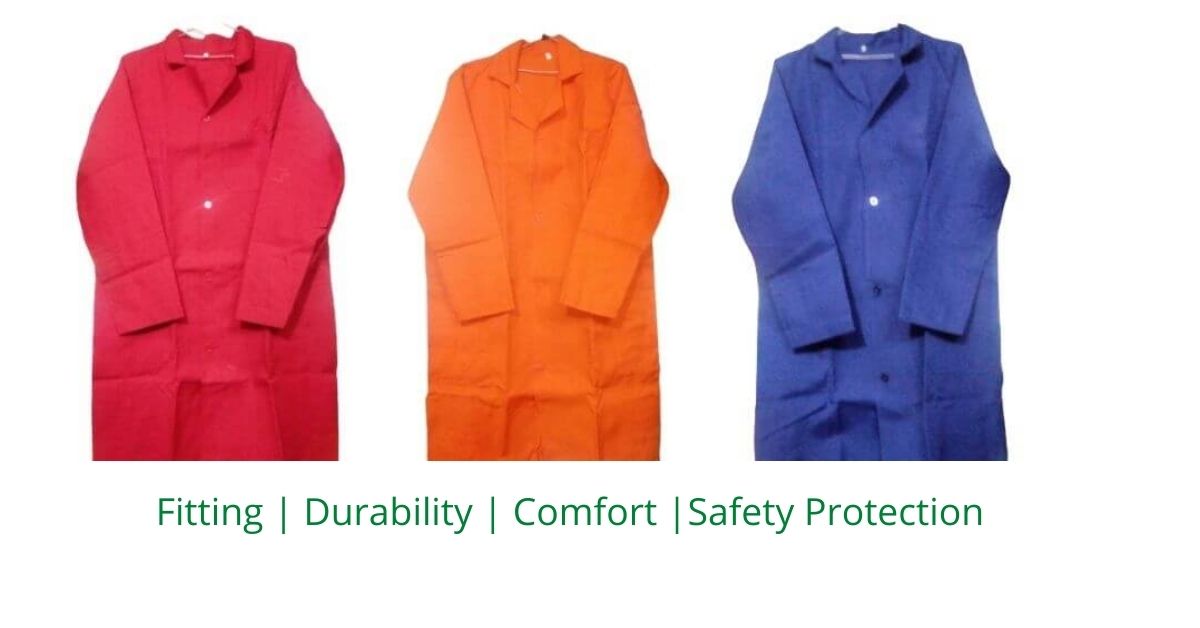- Empty cart.
- Continue Shopping
ASPECTS OF BEST DUST COATS

Best dust coats are loose-fitting, lightweight, long coats designed to protect a wearer’s clothes from dust, chemicals, and other workplace contaminants. These coats are a vital part of personal protective equipment (PPE), especially in industrial, laboratory, and workshop settings.
Available Sizes and Colors
Dust coats are available in various sizes, including Small, Medium, Large, and Extra-Large, ensuring a suitable fit for everyone. They also come in a range of standard colors such as:
-
Grey Dust Coats
-
Navy Blue Dust Coats
-
White Dust Coats
This variety allows for easy identification of roles or departments and enhances workplace organization.
Why Dust Coats Are Important
It only takes a minor equipment malfunction or accidental chemical spill to turn a regular workday into a tragedy. A recent incident at a renowned university (University of Nairobi) saw a researcher suffer severe burns due to an acid spill—highlighting the need for proper safety attire.
No workplace is entirely immune to accidents, which is why protective clothing is not optional—it’s essential.
The Role of PPE in the Workplace
Ensuring that every worker is equipped with appropriate PPE can significantly reduce risks and injuries. Over coats, Aprons, lab coats, and safety overalls form part of this essential equipment.
According to a study conducted at the University of Nairobi, hospital charges for burn treatments range between KES 20,000 and KES 50,000, depending on the duration of the hospital stay. Prevention is clearly more affordable than cure.
4 Key Factors to Consider When Purchasing the Best Dust Coats
1. Protection
The primary purpose of a dust coat is to offer maximum protection. Whether it’s a workshop or laboratory setting, the dust coat should be made from premium, non-permeable fabrics and stitched professionally to prevent any leakage of harmful substances.
According to the Occupational Safety and Health Administration (OSHA), it is mandatory for employers to provide and pay for PPE, including duster. These coats act as a first line of defense against workplace hazards.
Special Types of Dust Coats
-
Fire-Retardant Coats: Must be worn in areas with high heat exposure or near open flames.
-
Disposable Coats: Made from single-use material, these are ideal for high-contamination zones like cleanrooms and labs. They must be disposed of carefully to avoid spreading contaminants.
2. Comfort
Comfort is just as crucial as protection. An industrial coat should be:
-
Lightweight
-
Breathable
-
Flexible
Cotton dust coats are a top choice as they allow technicians and workers to move freely and adapt to various work positions without restriction.
3. Proper Fit
A good dust coat should be long enough to cover both the upper and lower body adequately. Pay attention to:
-
Sleeve length
-
Overall coat length
White lab coats, in particular, should not be too tight as tightness can limit mobility and make it harder to work efficiently.
4. Durability
For ongoing protection, a dust coat must be durable. Look for:
-
High-quality fabric
-
Double-stitched seams
-
Reinforced buttons or zippers
Durable coats ensure long-term use without compromising on safety.
Dust Coat Prices in Nairobi
At Safety Hub Enterprises, we manufacture high-quality, affordable workwear tailored for industrial and laboratory use. Our dust coats are priced competitively, and we take pride in ensuring both safety and value for money.
Contact us today to explore a wide range of safety wear, including dust coats, overalls, and lab gear.
Conclusion
Choosing the right dust coat for work is critical. It’s not just a uniform—it’s a safety tool. Always select coats that offer maximum protection, comfort, proper fit, and long-lasting durability.
Accidents can happen anytime—but the right gear helps you stay prepared and protected.
Frequently Asked Questions (FAQs)
1. What is the purpose of a dust coat?
A dust coat is an important workwear that protects clothing and skin from dust, chemicals, and workplace contaminants. It’s a basic but crucial form of PPE in many industries.
2. Are there specific dust coats for different work environments?
Yes. For example, fire-retardant coats are used in high-heat areas, and disposable dust coats are used in highly contaminated or sterile environments.
3. What materials are best for dust coats?
Cotton and poly-cotton blends are commonly used due to their comfort, breathability, and protective properties. For chemical protection, treated fabrics may be required.
4. How do I ensure a dust coat fits properly?
Ensure the coat is long enough to cover your torso and arms, but not so tight that it limits movement. Choose from available sizes and adjust as necessary.
5. Where can I buy affordable dust coats in Nairobi?
You can purchase high-quality, budget-friendly dust coats from Safety Hub Enterprises, which specializes in PPE and industrial workwear.






